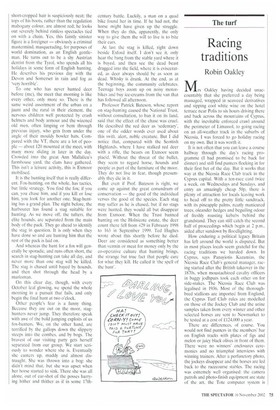Racing traditions
Robin Oakley
Mrs Oakley having decided unaccountably that she preferred a day being massaged, wrapped in seaweed derivatives and sipping cool white wine on the hotel terrace near Polls to six hours driving there and back across the mountains of Cyprus, with the inevitable enforced crawl around the perimeter of Limassol, to going racing on an all-weather track in the suburbs of Nicosia, I was forced to go holiday racing on my own. But it was worth it.
It is not often that you can leave a course halfway through the day's racing programme (I had promised to be back for dinner) and still find punters flocking in for their first bet of the day. But it works that way at the Nicosia Race Club track in the Cyprus capital. With a ten-race card twice a week, on Wednesdays and Sundays, and entry an amazingly cheap 50p, there is plenty of attraction for locals leaving work to head off to the pretty little sandtrack, with its pineapple palms, neatly manicured trees, oleander hedges and beguiling odour of freshly roasting kebabs behind the grandstand. They can still catch the second half of proceedings which begin at 2 p.m., aided after sundown by floodlighting.
How enduring a political legacy Britain has left around the world is disputed. But in most places locals seem grateful for the racing traditions we handed down. In Cyprus, says Panayiotis Kazamias, the Nicosia Race Club's general manager, racing started after the British takeover in the 1870s, when moustachioed cavalry officers in baggy jodhpurs took each other on for side-stakes. The Nicosia Race Club was legalised in 1936. Most of the thoroughbred stallions are imported from England, the Cyprus Turf Club rules are modelled on those of the Jockey Club and the urine samples taken from every winner and other selected horses are sent to Newmarket to be tested at a cost of £124,000 a year.
There are differences, of course. You would not find punters in the members' bar on English tracks with plates of figs and melon or juicy black olives in front of them. There were no winners' enclosures ceremonies and no triumphal interviews with winning trainers. After a perfunctory photo, the jockeys disappear and the horses are led back to the racecourse stables. The racing was extremely well organised: the camera patrols and photo-finish equipment are state of the art, the Tote computer system is formidable and the stewards' room viewing facilities are brilliant. But for my taste a little more ceremony would be welcome.
The riders, by British standards, are not particularly well rewarded. The monthly salary for a jockey is £321, with £100 buying you 85 Cyprus pounds. Apprentices get C£273. On top of that, riding fees are CE22 a race and the 29 jockeys employed at the track divided Ci183,000 between them as their 5 per cent share of prize money last year. Owners get a good deal, with a bigger percentage of the prize money than in Britain, and basic training fees are £250 a month per horse.
Some things, of course, are the same the world over, The commentary was, alas, all Greek to me. But by the end of the afternoon I could do a passable imitation of 'Go on. my son' in the noble tongue. And I had a pretty good idea of what 'That shifty little bastard never tried a yard' sounded like in Greek as well.
The informality was relaxing. [don't think I saw a tie in the parade ring all afternoon. And when the stalls handlers in their yellow T-shirts were brought back from the 1,600 metre start to the 1,200 metre jump-off they all piled into a little white shack on wheels in a way which reminded me of those student games involving how many people you could squeeze into a telephone box.
Finding winners proved easier than expected. The form so far as I could read it in the first made the favourite, Only Olivers, a cert. I was slightly disconcerted to see that he was ridden by one Chr. Pavlou, a piratical-looking figure with a goatee beard, a single gold earring and a ponytail. But Mr Pavlou rode a copybook race, jumping his mount into an early lead, giving him a breather before the final turn and keeping a bit in hand to beat off his single challenger. In the second, for two-year-old maidens. I was so taken with the appearance of Amathus Desire, a gorgeous chestnut filly, that I looked no further, despite some unfortunate racing colours that made her jockey look like a giant Neapolitan icecream. The further they went, the further she was ahead. I went for a coincidence bet on Lovely Christy in the third because a woman, a total stranger, once asked me to inscribe that in one of my books and then walked away without paying for it. I felt Lovely Christy owed me one. But, alas, sixth was the best she could manage.
I struck again though in the fifth race, backing the local champion jockey Nicos Nilolau on Asygritos. He stepped up the pace steadily from the front and won looking round. The nattiest thing on the course by far with his extra-elegant riding boots, immaculate breeches and trendy goggles, Nikolau looked the local equivalent of Frankie Dettori. Good thing he didn't try a flying dismount though. Try that in the chutes through to the weighing-room where most dismount and you could stun yourself on the roof. But three winners in five races I will settle for any day,



























































































 Previous page
Previous page